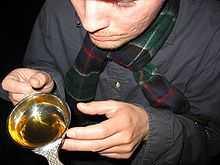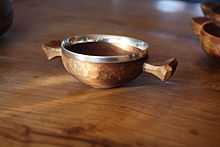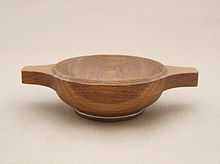Quaich

A quaich /ˈkweɪx/, archaically quaigh or quoich, is a special kind of shallow two-handled drinking cup or bowl in Scotland. It derives from the Scottish Gaelic cuach (Scottish Gaelic pronunciation: [kʰuəx]) meaning a cup.
According to the 1911 Encyclopædia Britannica, the quaich was inspired by the low silver bowls with two flat handles frequently used as bleeding vessels in England and the Netherlands in the 17th century. Another popular theory suggests that the shape is derived from scallop shells. However, this seems to have had its origins in the now discredited "Poems of Ossian".
In his 1955 monograph "Some Scottish Quaichs",[1] Richard L. McCleneahan, an American collector, suggests alternatively that quaichs evolved directly from medieval Mazers. This seems unlikely as the form and material (burr maple for mazers) are quite different. There were small stave built drinking vessels common in the medieval period found around the Baltic and since some of the earliest quaichs are stave built this could be the source.

The origin of quaichs in Scotland is traced to the Highlands[citation needed]; it was not until the end of the 17th century that they became popular in such large centres as Edinburgh and Glasgow. The silversmiths of such local guilds as Inverness and Perth frequently mounted them in silver, as may be seen from the hallmarks on the existing examples.
Commemorative quaichs awarded as prizes, or given as gifts, are more commonly made of pewter or silver. These prize cups are rarely used for actual drinking.
Related vessels to the Scottish quaich include the porringer, a larger vessel typically 6 inches (15 cm) in diameter with one (US colonial) or two (European) horizontal handles. The Sami and Norrland, Sweden, equivalent is the kuksa, which also only has a single handle.
The quaich was used for whisky or brandy, and in the 19th century Sir Walter Scott dispensed drams in silver quaichs, but the quaich he kept for himself was particularly precious to him.
In 1745 the quaich had travelled from Edinburgh to Derby with the Scottish Army in Bonnie Prince Charlie's canteen.
Some quaichs' bottoms are made of glass, allegedly so that the drinker could keep watch on his companions. A more romantic quaich had a double glass bottom in which was kept a lock of hair so that the owner could drink from his quaich to his lady love, and, in 1589, King James VI of Scotland gave Anne of Denmark a quaich or "loving cup" as a wedding gift[citation needed].
Notes
- ↑ McClenehan, Robert L. Some Scottish Quaichs. Illinois, 1955, p. 3.
See also
- Loch Quoich
- Centenary Quaich – a rugby football competition
External links
| Wikimedia Commons has media related to Quaich. |
![]() This article incorporates text from a publication now in the public domain: Chisholm, Hugh, ed. (1911). Encyclopædia Britannica (11th ed.). Cambridge University Press
This article incorporates text from a publication now in the public domain: Chisholm, Hugh, ed. (1911). Encyclopædia Britannica (11th ed.). Cambridge University Press